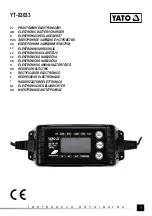Reviews:
No comments
Related manuals for AHR32113M1Ultra-B

Evon
Brand: Malmbergs Pages: 16

BP8302
Brand: WARRIOR Pages: 15

ACC-001-33THK
Brand: DT Research Pages: 2

GAL 18V-160
Brand: Fein Pages: 161

CH-L1115
Brand: AA Portable Power Corp Pages: 2

EBL20-12027
Brand: patura Pages: 16

AL 600 compact
Brand: H-Tronic Pages: 7

APA750EU
Brand: Targus Pages: 30

Onyx 150
Brand: Duratrax Pages: 6

50048
Brand: Sunforce Pages: 1

CH0004
Brand: Ultralife Pages: 15

Cleco Series
Brand: Cooper Pages: 8

YT-83033
Brand: YATO Pages: 64

Fontastic Witra
Brand: D-Parts Pages: 2

APA042EU
Brand: Targus Pages: 26

TEA268
Brand: Livoo Pages: 5

AC-MANAGE
Brand: Anywhere Cart Pages: 12

EVC-M-32S2R2350
Brand: Eaton Pages: 350

















